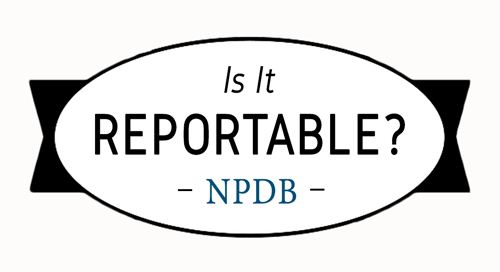The NPDB is Working for You
 The NPDB employs many specialists whose job is to provide customized assistance to users, from those who query the NPDB to those whose information resides in the NPDB, to the general public, researchers, and the media. The NPDB regularly assists users so that all information in the NPDB is accurate and accessible to those authorized to view it.
The NPDB employs many specialists whose job is to provide customized assistance to users, from those who query the NPDB to those whose information resides in the NPDB, to the general public, researchers, and the media. The NPDB regularly assists users so that all information in the NPDB is accurate and accessible to those authorized to view it.
Below are examples of the ways the NPDB is reaching out and helping our user communities:
- Health care professionals: The NPDB assists practitioners with completing a Self-Query application, which allows the practitioner access to their own information. Practitioners who have information stored in the NPDB can visit the NPDB website to receive instructions on how to access their report, submit a subject statement, dispute a report, and more. The NPDB helps practitioners who need assistance resolving reporting issues. For example, the NPDB reached out to a medical malpractice payer on behalf of a practitioner to advise the payer to, rather than report the practitioner each time they made a payment, submit only one report for the entire settlement.
- Hospitals and other health care organizations: NPDB professionals assist organizations in meeting their reporting and querying obligations through webinars, fact sheets, flow charts, other policy help over the phone, as well as through education forums and other person-to-person outreach. NPDB professionals work closely with state boards to help them meet legal obligations. One board did not have the resources to query all applicants in a timely manner. The board asked if Self-Query could be an option for their applicants. The NPDB provided instructions for the board to post on their website that instructed practitioners on how to perform a Self-Query that could be included with the completed application.
- The general public: The Public Use Data File, Data Analysis Tool, and Compliance pages are other resources that researchers, the media, and any other parties may use. These contain anonymized statistical data regarding the information in the NPDB. The NPDB also reviews state boards’ websites to ensure all information reportable to the NPDB is available to its user community in order to carry out the NPDB's mission of protecting the public and preventing health care fraud and abuse.
The NPDB is looking for more opportunities to assist our user community. If you would like the NPDB to provide assistance, clarification, or reporting guidance, please send us an email or contact the NPDB Customer Service Center.
Is It Reportable?
 A court rules to settle a medical malpractice claim for expenses only. The defendant is released from the claim and the malpractice payer settles with the plaintiff’s attorney for the amount of fees and expenses incurred by the plaintiff. Is this type of payment reportable to the NPDB?
A court rules to settle a medical malpractice claim for expenses only. The defendant is released from the claim and the malpractice payer settles with the plaintiff’s attorney for the amount of fees and expenses incurred by the plaintiff. Is this type of payment reportable to the NPDB?
No. Reportable medical malpractice payments are limited to exchanges of money and must be the result of a written complaint or claim demanding monetary payment for damages relating to medical care. These fees, known as loss adjustment expenses (LAEs), refer to expenses other than those in compensation of injuries, such as attorney fees, billable hours, copying costs, expert witness fees, and deposition and transcript costs. Reimbursement of these fees are not reportable to the NPDB in and of themselves. LAEs should only be reported to the NPDB if they are included in a medical malpractice settlement.
For more information regarding medical malpractice payment reports, see the NPDB Guidebook Chapter E: Reports, Reporting Medical Malpractice Payments.
Has Your Organization's Information Changed Recently?
 Has your organization's information changed? Specifically, have there been any recent acquisitions or corporate mergers? Was it acquired by, or did it acquire, another health care organization to form a new entity? If your organization is under new ownership or has undergone a merger, you must update the organization's information in the NPDB to reflect these changes.
Has your organization's information changed? Specifically, have there been any recent acquisitions or corporate mergers? Was it acquired by, or did it acquire, another health care organization to form a new entity? If your organization is under new ownership or has undergone a merger, you must update the organization's information in the NPDB to reflect these changes.
If your organization has been acquired or merged with another organization, and you no longer need your Data Bank Identification Number (DBID), you may need to transfer your DBID to the new organization's NPDB account (if they are already registered with the NPDB). You should set up a successor account when you deactivate your organization's DBID. This allows records from the old DBID to transfer over to the new account. By no means should you let the DBID expire – this may result in the loss of access to your historical querying and/or reporting data.
To start this process, please send a letter via email (scanned), fax, or mail on your company letterhead with the following information:
- Specify the DBID you are requesting to be deactivated, and state your reason,
- The successor account's information (the successor organization's name and DBID), and
- Include the signature and contact information of your certifying official (the individual listed on an organization's NPDB registration profile).



 CLOSE
CLOSE